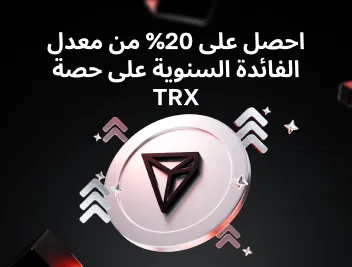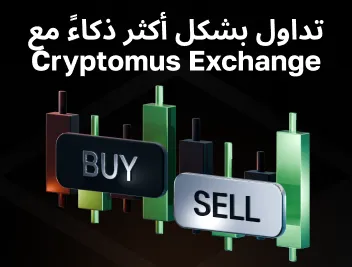
تداول إيثريوم للمبتدئين: الأساسيات، الأنواع، والاستراتيجيات
Ethereum هو ثاني أكثر العملات المشفرة شعبية بعد Bitcoin. الطلب الكبير عليه مرتبط بوظائف شبكة Ethereum التى تشمل كلًّا من التعامل مع تطبيقات dApp مختلفة وإجراء المعاملات باستخدام عملتها ETH. منذ ظهور الشبكة في عام 2013، اجتذبت الكثير من الاستثمارات الهادفة للتداول. في هذا المقال، سنخبرك بالمزيد عن تداول Ethereum، استراتيجيات وأنواع هذه العملية، ونقدّم لك خوارزمية خطوة بخطوة حول كيفية بدء تداول ETH.
ما هو تداول ETH وكيف يعمل؟
تداول ETH يعني الشراء والبيع المنتظم لهذه العملة المشفرة لتحقيق الربح من تغيّرات الأسعار. لذا، كلما ارتفعت قيمة العملة في السوق، كان بيعها أكثر ربحًا، وكلما انخفض السعر، كان الشراء أكثر فائدة.
عادةً، يحدث تداول Ethereum على بورصات العملات المشفرة ومتاحة على مدار الساعة طوال أيام الأسبوع بما في ذلك عطلات نهاية الأسبوع. يستخدم المتداولون أنواعًا مختلفة من الأوامر لإجراء الصفقات، مثل أوامر السوق (market orders) والأوامر المحددة (limit orders). أمر السوق ينطوي على شراء أو بيع الأصول بالسعر الحالي، والأوامر المحددة تعني تنفيذها بسعر محدد. ولإيجاد اللحظة المثلى لإجراء الصفقة، يحلل المتداولون ديناميكيات سوق العملات المشفرة.
استراتيجيات تداول Ethereum
استراتيجيات تداول ETH هي النهج التي يستخدمها المتداولون عند شراء أو بيع العملات. هذه الاستراتيجيات لها مستويات مخاطرة مختلفة وقد تناسب حالات سوقية مختلفة وتفضيلات المتداولين. من بينها التداول اليومي (day trading)، التداول التقلبّي (swing trading)، الاحتفاظ طويل الأمد (HODLing)، متوسط تكلفة الدولار (dollar‑cost averaging ، DCA)، والتداول عند الاختراق (breakout trading). نلقي نظرة أكثر تفصيلاً على كل منها أدناه.
التداول اليومي (Day Trading)
استراتيجية التداول اليومي تشمل شراء وبيع ETH خلال يوم واحد. تفترض هذه الطريقة تحقيق ربح من تقلبات السعر قصيرة الأمد وتجنّب مخاطر تغيّراتها القوية التي قد تحدث في الليل. تتطلب استراتيجية اليوم مراقبة دقيقة للسوق، لذا يستخدم المتداولون المخططات والمؤشرات للتنبؤ مثل RSI.
التداول التقلبّي (Swing Trading)
التداول التقلبّي ينطوي على احتفاظ بعملات ETH لفترة أطول تمتد من أيام إلى أسابيع. بهذه الطريقة، يمكن للمتداولين استغلال تقلبات السعر المتوسطة الأمد، والتي تكون أكبر من تلك اليومية. هذا النهج مناسب لأولئك المستثمرين في العملات المشفرة الذين لا يملكون الفرصة لمراقبة السوق بشكل مستمر لكنهم يرغبون في الربح من تغيّرات سعر ETH.
الاحتفاظ طويل الأمد (HODLing)
استراتيجية HODLing تعني الاحتفاظ بعملات Ethereum لفترة طويلة. تفترض الطريقة الحد الأدنى من التداول النشط؛ أي التركيز على الأرباح طويلة الأجل بدلاً من النظر إلى تقلبات السعر اليومية أو الأسبوعية. ويعود ذلك إلى أن من يتبنون هذا النهج يؤمنون بإمكانات Ethereum ويتوقعون ارتفاع سعره مع توسّع الشبكة.
متوسط تكلفة الدولار (Dollar‑Cost Averaging – DCA)
تشمل هذه الاستراتيجية الاستثمار المنتظم بمبلغ ثابت من المال في Ethereum بصرف النظر عن سعره في السوق. على سبيل المثال، كل شهر يمكنك استثمار 500 دولار. مثل هذا النهج يتيح لك موازنة القيمة وتجنّب التقلب؛ أي أنك تشتري المزيد من ETH عندما يكون سعره منخفضًا وأقل عندما يكون أعلى. هكذا، يكون DCA مثاليًا للمتداولين الذين يرغبون في تحقيق ربح من ETH دون مخاطر تقلبات السعر الكبيرة.
التداول عند الاختراق (Breakout Trading)
التداول عند الاختراق يتعلق بالاستثمار عندما يتجاوز سعر Ethereum دعمًا (الحد الأدنى للسعر) أو مقاومة (الحد الأقصى للسعر). مثال: إذا كان ETH يتداول بين 3,300 و3,500 دولار لعدة أسابيع، فإن حدث الاختراق يحدث عندما ينخفض السعر إلى أقل من 3,300 دولار أو يزيد عن 3,500 دولار. في تلك اللحظات، يشتري أو يبيع المتداولون ETH للاستفادة من تغيّرات السعر الحادة.
أنواع تداول Ethereum
على عكس الاستراتيجيات، تشير أنواع تداول Ethereum إلى تفاصيل عملية شراء أو بيع الأصول الرقمية. على سبيل المثال، بعض المتداولين يرغبون في الربح بأسرع وقت ممكن، بينما الآخرون يحتفظون بـ ETH كاستثمار طويل المدى. هيا نلقي نظرة أقرب على هذه الأنواع.
التداول الفوري (Spot Trading)
التداول الفوري يعني شراء وبيع ETH بسعر السوق الحالي باستخدام أموال فورية. بعبارة أخرى، هو تداول قصير الأجل. في هذه الطريقة، تضع طلبًا — على سبيل المثال، لشراء ETH — وتجد البورصة لك طلب بيع مطابق.
في بورصة Cryptomus، يتم تسهيل تداول Ethereum الفوري وجعله في متناول الجميع. توفر المنصة تتبّعًا في الوقت اللحظي لسعر ETH وتقدّم أكثر من 100 زوج تداول، مما يضمن سيولة عالية وتنفيذًا سريعًا. من خلال واجهة مستخدم سهلة ورسوم قريبة من الصفر لكل من المتخذين والمنشئين، تجعل Cryptomus تداول Ethereum مريحًا ومربحًا على حد سواء. سواء كنت تبحث عن شراء Ethereum لفترة طويلة أو تريد التداول سريعًا للاستفادة من تقلبات السوق، فإن Cryptomus توفر الأدوات التي تحتاجها لتجربة تداول سلسة.
تداول الهامش/الرفع المالي (Margin/Leverage Trading)
هذا نوع من التداول بالهامش والمرفوع ماليًا. يفترض أنك تقترض أموالًا من البورصة للقيام بتداول بـ Ethereum. تتيح لك هذه الطريقة السيطرة على المزيد من عملات ETH بأقلّ قدر من رأس المال المبدئي.
على سبيل المثال، لديك 3,000 دولار بينما تبلغ قيمة العملة 3,500 دولار؛ في هذه الحالة، يمكنك استخدام رفع مالي 5× وشراء ETH بقيمة 15,000 دولار. إذا ارتفع سعر العملة بنسبة 4٪ فقط، فسوف تحقق ربحًا بنسبة 20٪ على استثمارك المبدئي بفضل الرفع المالي 5×، لكن إذا انخفض بنسبة 20٪، فستواجه التصفية وتخسر كل أموالك. نظرًا لمثل هذه الصعوبات، غالبًا ما يختار هذا النوع من التداول المستخدمون ذوو الخبرة الذين يمكنهم التنبؤ بالمخاطر. تتوفّر هذه النوعية من التداول عبر Bybit و Binance.
تداول العقود الآجلة (Futures Trading)
في تداول العقود الآجلة، يدخل المستثمرون في عقد يوافقون فيه على شراء أو بيع ETH بسعر محدد في تاريخ معين في المستقبل. ستكون الصفقة مربحة إذا كانت القيمة السوقية للعملة في اليوم المُعيّن أعلى مما كانت عليه سابقًا، لأن المتداول يشتري بالسعر المتفق عليه. لكن سيكون هناك خسارة إذا أصبح سعر ETH أدنى. غالبًا ما يختار تداول العقود الآجلة أيضًا المتداولون الذين لديهم فهم جيد لاتجاهات السوق. يستخدمون منصات تشفير مثل Bybit و Binance.
تداول الخيارات (Options Trading)
هذا النوع من تداول ETH يعمل مثل العقود الآجلة، حيث يُفترض شرط شراء أو بيع العملات في تاريخ معين في المستقبل. ومع ذلك، تمنح الخيارات المتداولين الحق في إجراء صفقة قبل التاريخ المحدد. على سبيل المثال، يمكن للمرء استخدام خيار والاستفادة من الأصول نتيجة توقع ارتفاع أو انخفاض في قيمة العملة المشفرة. ميزة تداول الخيارات متاحة في بورصات مثل OKX و MEXC.
البيع على المكشوف (Short Selling)
طريقة البيع على المكشوف لـ Ethereum تعني تحقيق الربح من انخفاض سعر العملة. في هذه الحالة، يستعير المتداول ETH من وسيط (بورصة العملات المشفرة) ويبيعها بالسعر الحالي في السوق. ثم يشتري تلك العملات مرة أخرى بسعر أقل، ويعيد العملة المقترضة إلى الوسيط، ويأخذ الفرق كربح. ومع ذلك، فإن البيع على المكشوف محفوف بالمخاطر لأن سعر ETH قد يرتفع ويؤدي إلى خسائر. يمكن تنفيذ هذه الطريقة على بورصات Binance أو Bybit.
المراجحة (Arbitrage)
طريقة المراجحة في تداول Ethereum تشير إلى تحقيق الربح من الفرق في سعر العملة على بورصات مختلفة. إذًا، يشتري المتداولون ETH بسعر منخفض على منصة واحدة ويبيعونها بسعر أعلى على أخرى. لهذه الطريقة مخاطر منخفضة، ولكن يجب أن تفعل كل شيء بسرعة لأن فروق السعر تُحل بسرعة. لاستخدام هذه الطريقة، يجب أن تختار بورصات ذات واجهة مريحة مثل Cryptomus.
التداول الآلي (Automated Trading / Bots)
تستخدم بوتات التداول الآلي لإيثريوم برامج تسمح بإجراء الصفقات بشكل مستقل بناءً على استراتيجيات محددة وظروف روبوتات التداول الآلي لـ Ethereum تستخدم برنامجًا يسمح بتنفيذ الصفقات بشكل مستقل بناءً على استراتيجيات محددة وظروف السوق الحالية. فهي تراقب بيانات السوق على مدار الساعة طوال أيام الأسبوع، لذا تُصدر قرارات أكثر دقة وأسرع مقارنة بالأسلوب اليدوي. للنجاح في استخدام الروبوتات، تحتاج إلى معرفة تقنية واختيار استراتيجية مثالية.

كيفية بدء تداول Ethereum؟
الآن، دعنا نلقي نظرة أوضح على كيفية تداول Ethereum في بورصات العملات المشفرة. العملية متشابهة على جميع المنصات، بغض النظر عن الاستراتيجية المُختارة، لذا ستكون الخطوات متطابقة. إليك الخطوات خطوة‑بخطوة:
-
الخطوة 1: اختر استراتيجية ونوع التداول. قرّر أي نهج تداول Ethereum وما الطريقة التي أوضحناها أعلاه تناسبك.
-
الخطوة 2: اختر بورصة العملات المشفرة. اختر المنصة التي ستتداول عليها ETH. يجب أن تكون بورصة تتيح لك التداول بالطريقة التي اخترتها، وأن تكون معتمدة وموثوقة، وتوفر أساسًا تشغيليًا واسعًا، وتقدّم تدابير أمنية قوية. يُنصح المبتدئون باختيار منصات خاضعة لتنظيم صارم، لأن نقص الخبرة يزيد من مخاطر الوقوع ضحية للمحتالين. على سبيل المثال، بورصة Cryptomus تحمي البيانات والأموال من خلال مراقبة AML والمصادقة الثنائية 2FA، لذا يمكن للمتداولين العمل هناك بطمأنينة.
-
الخطوة 3: أنشِئ حسابًا. سجّل على المنصة التي اخترتها من خلال تقديم اسمك وعنوان بريدك الإلكتروني. اجتز إجراءات التحقق وKYC؛ من أجل ذلك، جهّز جواز سفر أو رخصة قيادة، واستعد لالتقاط سيلفي لإثبات هويتك.
-
الخطوة 4: مَوّل حسابك. أودع أموالًا في حسابك لدى البورصة، سواء كانت عملة نقدية (فيات) أو عملة مشفرة. بعض البورصات تسمح أيضًا بـشراء Ethereum باستخدام بطاقة ائتمان أو بطاقة خصم.
-
الخطوة 5: حدّد زوج التداول الخاص بك. بعد ذلك، تحقّق من العملة التي أودعتها وعدد ETH الذي تخطّط لشرائه. في بورصة Cryptomus، إذا كنت تريد شراء ETH بسعر معين، فستحتاج إلى وجود مبلغ مساوي بـ USDT أو USDC. في هذه الحالة، سيكون زوج التداول “ETH/USDT” أو “ETH/USDC”.
-
الخطوة 6: نفّذ الصفقة. تصرّف وفقًا لطريقة التداول التي اخترتها: انتقل إلى الصفحة المطلوبة، أدخل البيانات (مثال: أمر سوق أو أمر محدد)، ثم أكد العملية. الآن يمكنك متابعة وإدارة تداولك.
نصائح لتداول ETH وجني الأرباح
لتقليل المخاطر عند تداول إيثريوم وتحقيق أقصى قدر من الربح، يجب عليك الاقتراب من العملية بعناية. لقد جمعنا لك لتقليل المخاطر عند تداول Ethereum ولتحقيق أقصى ربح ممكن، يجب أن تتعامل مع العملية بحذر. لقد جمعنا لك بعض التوصيات بهذا الشأن:
-
اختر بورصة عملات مشفرة موثوقة. تداول على منصة يكون فيها ETH تحت حماية موثوقة. كما يعتبر من المهم أيضًا أن تأخذ بعين الاعتبار قيمة العملة في البورصة، حجم التداول (السيولة)، ومقدار الرسوم، التي يمكن أن تؤثر أيضًا على أرباحك.
-
راقب السوق. اطلع على أخبار سوق العملات المشفرة بانتظام لتبقى مطلعًا على التغيّرات، بما في ذلك شبكة Ethereum. خذ بعين الاعتبار توجهات السوق لفهم إلى أين يتجه سعر العملة.
-
استخدم التحليل الفني. تعلم كيف تقرأ مخططات سعر ETH واستخدم مؤشرات فنية. هذا سيساعدك على تحديد اتجاهات السوق.
-
إدارة المخاطر. تداول فقط بالمبلغ الذي يمكنك تحمُّل خسارته في حال هبوط مفاجئ للسعر. حاول ألا تستخدم مبالغ كبيرة مُقترَضة لحماية أصولك من التقلبات.
اتبِع هذه القواعد لتتداول ETH بأمان وبربحية. حتى مع مرور الوقت، وعندما تصبح متداولًا أكثر خبرة، فإنه من المفيد التذكير بعدم قدرة سوق العملات المشفرة على التنبّؤ، لا سيّما مع نموّه. بهذه الطريقة، فإن الاستراتيجيات وأنواع تداول Ethereum التي تختارها ستجلب لك فقط أرباحًا مستقرة.
نأمل أن تكون هذه المقالة مفيدة لك، والآن ستكون قادرًا على اتخاذ قرار مستنير حول أي استراتيجية ونوع ستستخدمه نأمل أن تكون هذه المقالة مفيدة لك، والآن ستكون قادرًا على اتخاذ قرار مطّلع بشأن الاستراتيجية والنوع الذي ستستخدمه في تداول ETH. ربما لديك بالفعل تجربة في شراء أو بيع هذه العملة؟ شاركها في التعليقات!
قيم المقال








تعليقات
0
يجب أن تكون مسجلا للدخول لتكتب تعليق